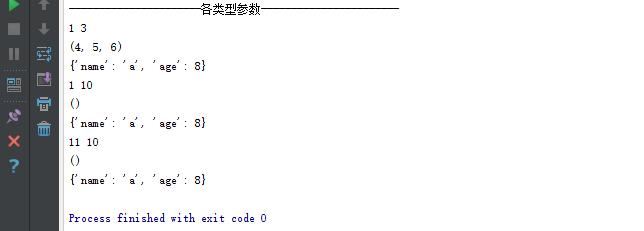一、函数定义&特性&返回值
1、函数定义
函数是指将一组语句的集合通过一个名字(函数名)封装起来,要想执行这个函数,只需调用其函数名即可。
2、函数特性
1)减少重复代码
2)使程序编的可扩展
3)使程序变得易于维护
1 import time 2 3 def test1(): 4 time_format = '%Y-%m-%d %X' 5 time_current = time.strftime(time_format) 6 print(time_current) 7 return 0 8 9 test1() 10 x= test1() 11 print(x)
3、函数返回值
#return:函数执行结果,为后续执行程序提供判断依据。
#无:返回None
#返回一个值,一个对象
#返回多个值,包装成元组
1 def test1(): 2 print('in the test1') 3 4 def test2(): 5 print('in the test2') 6 return 0 7 8 def test3(): 9 print('in the test3') 10 return 1,[1,2],{'a':'b'} 11 12 def test4(): 13 print('in the test4') 14 return test2 15 16 x = test1() 17 y = test2() 18 z = test3() 19 #返回test2函数 20 v = test4() 21 #调用 22 v1 = v() 23 24 print(x,type(x)) 25 print(y,type(y)) 26 print(z,type(z)) 27 print(v,type(v)) 28 print(v1,type(v1))
二、函数参数
#函数参数
#形参变量只有在被调用时才分配内存单元,在调用结束时,即刻释放所分配的内存单元。
# 因此,形参只在函数内部有效。函数调用结束返回主调用函数后则不能再使用该形参变量。
#实参可以是常量、变量、表达式、函数等,无论实参是何种类型的量,在进行函数调用时,它们都必须有确定的值,
# 以便把这些值传送给形参。因此应预先用赋值,输入等办法使参数获得确定值。
1、简单参数
1 print('-'.center(50,'-')) 2 def test1(x,y,z): 3 'aaaaa' #函数说明 4 print(x,y,z) 5 6 test1(1,3,5) #位置参数调用:形参-实参一一对应。 7 test1(y=3,x=1,z=5) #关键字调用:与形参顺序无关 8 #test1(y=3,1,5) #报错 9 #test1(3,z=1,5) #报错 10 test1(1,z=5,y=3) #混合调用:关键参数必须在位置参数后面
2、默认参数
1 print('默认参数函数'.center(50,'-')) 2 #默认参数:默认参数可以多个,但必须在非默认参数后。 3 #特点:函数调用时,默认参数非必须传递 4 #用途:自己想 5 def test2(x,y,z=5,v=6): 6 'aaaaa' 7 print(x,y,z,v) 8 9 test2(1,2) 10 test2(1,2,v=7)

3、参数组
1 #参数组作用:为后期函数拓展做准备 2 print('不固长参数函数(参数组):元组形式'.center(50,'-')) 3 def test3(x,y=2,*args): 4 print(x,y) 5 print(args) 6 #接收位置参数作,转化为元组 7 test3(1,2,3,4,5) 8 #test3(1,y=10,3,4,5) #关键字参数必须在位置参数后 9 #test3(1,3,4,5,y=10) #3被当做默认参数传递,y=10,再次传递,出错 10 test3(1,7,*(8,9)) #test3(1,*[7,8,9]) ,test3(1,*{7:1,8:2,9:3}) #转化为元组 11 12 print('不固长参数函数(参数组):字典形式'.center(50,'-')) 13 def test4(x,y=2,**kwargs): 14 print(x,y) 15 print(kwargs) 16 17 #接收关键字参数作,转化为元组 18 test4(1,3,name='a',age=8) 19 test4(1,3,**{'name':'a','age':8}) 20 test4(1,name='a',age=8,y=10)


4、各类型参数
1 #参数顺序:1)普通参数、默认参数、元组参数组、字典参数组,建议使用这种。 2 # 2)普通参数、元组参数组、默认参数、字典参数组 3 print('各类型参数'.center(50,'-')) 4 def test5(x,y=2,*args,**kwargs): 5 #def test5(x,*args,y=2,**kwargs): 6 print(x,y) 7 print(args) 8 print(kwargs) 9 10 test5(1,3,4,5,6,name='a',age=8) 11 test5(1,name='a',age=8,y=10) #除非元组参数组不定义值,否则只能按顺序赋值 12 test5(name='a',age=8,y=10,x=11) 13 #建议按照顺序,别搞那么多幺蛾子。。。。。

三、局部变量&全局变量
1 #全局与局部变量 2 # 在子程序中定义的变量称为局部变量,在程序的一开始定义的变量称为全局变量。 3 # 全局变量作用域是整个程序,局部变量作用域是定义该变量的子程序。 4 # 当全局变量与局部变量同名时: 5 # 在定义局部变量的子程序内,局部变量起作用;在其它地方全局变量起作用。 6 7 school = 'gd' 8 sch_glo = 'gx' 9 10 def charge_name(name): 11 print('before name: ',name) 12 name = name.upper() 13 print('after name: ',name) 14 school = 'gddddddd' 15 print('fnc school:',school) 16 global sch_glo #申明为全局变量:不要这么干 17 sch_glo = 'gxxxxxxx' 18 print('fnc sch_glo:',sch_glo) 19 global name_glo 20 name_glo = 'czzzzzzzzzz' #定义全局变量:永远永远永远不要这么干 21 print('fnc name_glo:',name_glo) 22 23 name = 'cz' 24 print(name) 25 charge_name(name) 26 print(name) 27 print(school) 28 print(sch_glo) 29 print(name_glo) 30 31 32 print(''.center(50,'-')) 33 list_name = ['aa','bb','cc'] 34 35 def charge_name2(list): 36 list[0] = 'aaaaaa' 37 print('in fnc: ',list) 38 39 charge_name2(list_name) 40 print(list_name) 41 #what the fuck...,被修改了。why?引用传递问题。